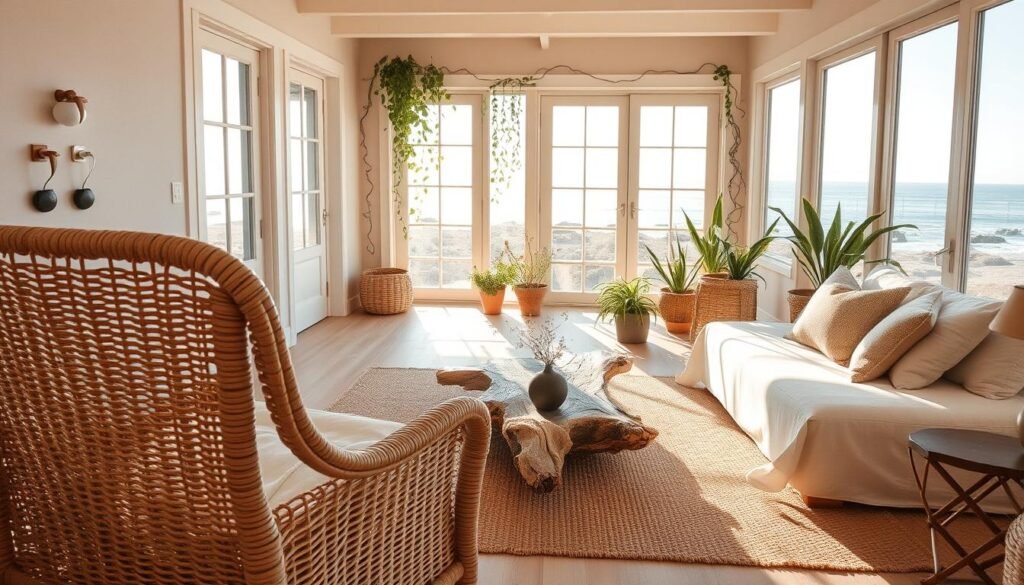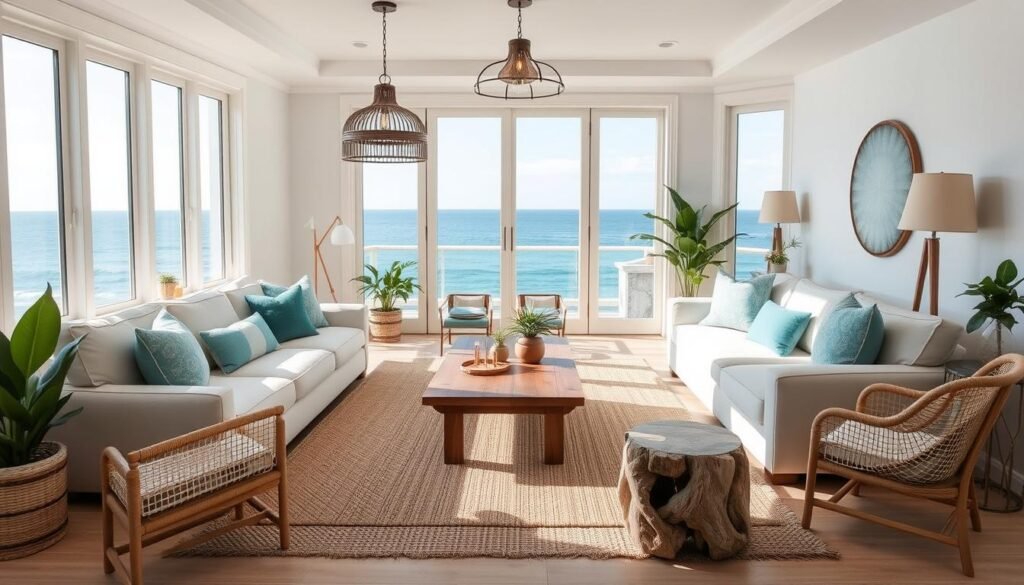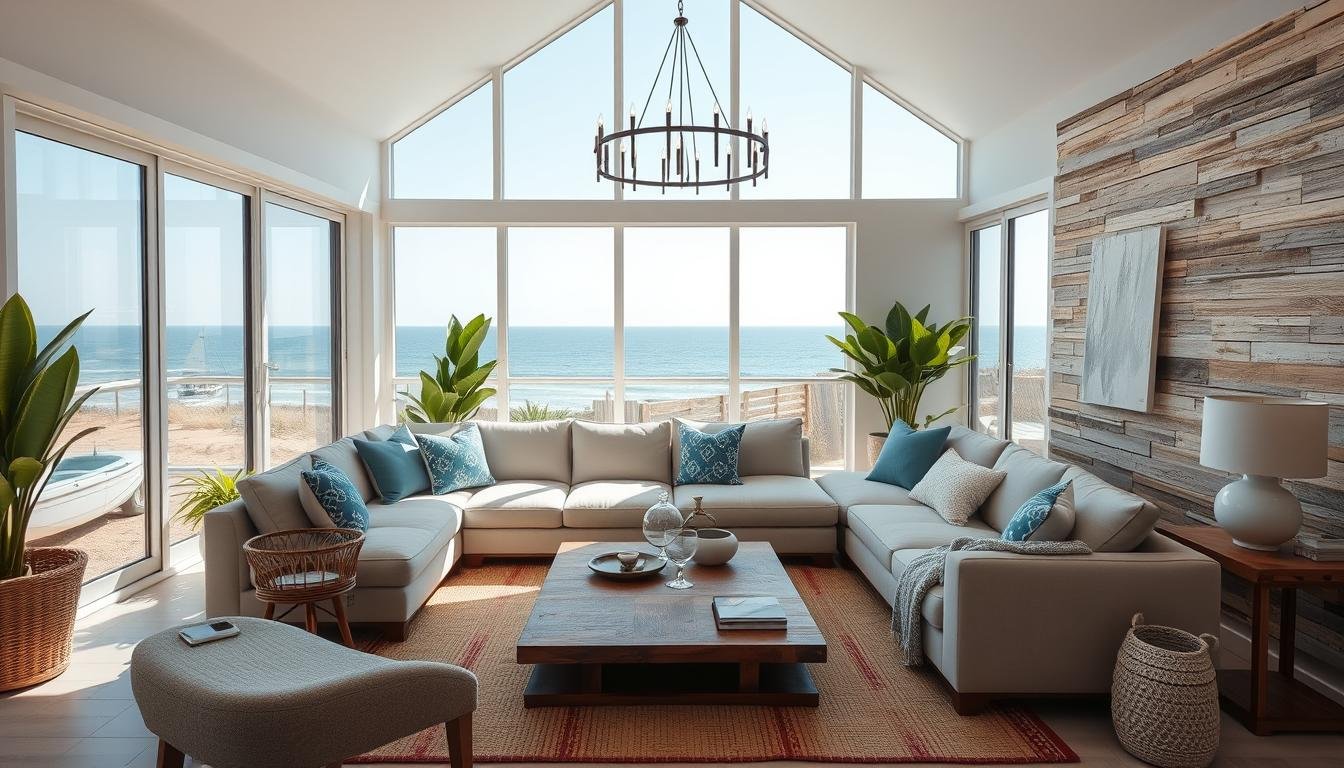This post may contain affiliate links. When you purchase through links on our site, we may earn an affiliate commission.
I’ve always believed your living space should feel like a peaceful escape. That’s why I love blending breezy seaside vibes with clean, contemporary touches. This approach creates rooms that whisper relaxation while keeping things stylish and functional.
You don’t need ocean views to capture that light, airy atmosphere. Soft blues and sandy neutrals work like magic to set the mood. Pair these with natural textures – think rattan chairs or linen curtains – to add depth without clutter.
What makes today’s beach-inspired style special is its flexibility. It’s not about anchor motifs or rope details anymore. Instead, focus on quality pieces that balance comfort and sophistication. A sleek sofa with driftwood accents or minimalist shelving displaying sea glass collections can make all the difference.
I’ll show you how to mix practical elements with those vacation-ready feels. We’ll explore lighting choices that mimic sunlight on water and storage solutions that keep spaces feeling open. The best part? These concepts adapt easily whether you’re redoing a city apartment or a countryside cottage.
Key Takeaways
- Combine airy color schemes with natural textures for relaxed elegance
- Choose furniture that balances contemporary lines with organic materials
- Use lighting strategically to enhance spacious, sunlit atmospheres
- Incorporate subtle oceanic references through art and accessories
- Focus on multi-functional pieces to maintain clutter-free zones
- Adapt coastal elements to any architecture or geographic location
Setting the Scene: The Allure of Coastal Living
You don’t need a beach house to experience waterfront serenity. What makes these environments special isn’t geography—it’s how they make us feel. Crisp air, sun-bleached woods, and the soft crash of waves create a rhythm that slows our pulse and clears our minds.
https://www.youtube.com/watch?v=qUfOb5-QDFk
I’ve discovered three essential ingredients for capturing that seaside magic:
| Traditional Coastal | Contemporary Approach | Key Benefit |
|---|---|---|
| Nautical patterns | Subtle wave textures | Adds movement |
| Dark wood accents | Whitewashed oak finishes | Brightens spaces |
| Overhead lighting | Layered ambient lamps | Softens atmosphere |
Light plays a crucial role. “Morning light through linen curtains creates liquid gold pools on floors,” a client once told me. That’s the essence we want—spaces that live with natural rhythm.
Textures matter more than themes. A chunky knit throw over a streamlined sofa says relaxation without shouting ‘beach house’. Woven baskets store blankets while adding organic warmth. These choices help any room breathe like coastal air.
True waterfront living isn’t about decor—it’s designing spaces that move at low tide’s pace. Whether you’re in Kansas or Key West, that peaceful mindset translates beautifully.
modern coastal decor inspiration
What transforms ordinary spaces into serene retreats? Thoughtful layering of contrasts. I recently visited a living area that perfectly captured this balance – crisp white walls met weathered oak beams, while a streamlined sofa hugged a chunky jute rug. This interplay between polished and organic elements defines today’s approach to seaside-inspired rooms.
Interior expert Tracy Svendsen nails it: “Coastal artwork should whisper, not shout.” I’ve found that abstract ocean prints or minimalist driftwood sculptures work better than literal anchors. These pieces add character while keeping the calm essence intact. Textures do the heavy lifting – try pairing smooth marble side tables with nubby linen throw pillows.
The secret lies in editing. I always ask: “Does this item serve beauty and purpose?” Woven baskets store remotes. Glass lamps mimic sunlight on waves. Every choice should reinforce that airy, uncluttered feeling we love about waterfront spaces.
Rooms that truly sing use color strategically. Soft aqua walls? Yes. Neon coral pillows? Maybe one. I stick to three main hues maximum, letting materials provide visual interest. A cerused wood coffee table becomes the star when surrounded by muted tones.
What excites me most is how these principles adapt. Whether you’re styling a compact city loft or sprawling country home, that breezy elegance translates beautifully. It’s not about location – it’s about cultivating that easy, sun-drenched mindset.
Embracing a Coastal Color Palette for Your Dream Home
Creating a coastal-inspired home begins with colors that mirror nature’s tranquility. I’ve seen firsthand how strategic combinations can turn any room into a soothing retreat. Take cues from Ron Brenner Architects’ work – their layered blue hues against crisp whites prove neutral backdrops let accent tones shine.

Choosing the Right Shades
Light quality dictates everything. North-facing rooms? Try warm sky blues to counter gray undertones. South-facing spaces? Cool navy tones prevent overwhelming brightness. This table shows my go-to combinations:
| Base Color | Light Effect | Best Pairings |
|---|---|---|
| Seafoam | Softens midday glare | Pearl gray, oat |
| Slate blue | Adds depth at dusk | Driftwood, cream |
| Pale aqua | Reflects morning light | Sandstone, flax |
Green plays a quiet hero. Sage throw pillows or sea glass vases introduce organic warmth without competing with blue’s dominance. Remember – these shades should echo the coast, not replicate it.
Incorporating Bold Accents
Kate Lester taught me bold doesn’t mean brash. A single coral lampshade or mustard velvet stool energizes neutral spaces. “Let fixtures become jewelry,” she advises. Try brass sconces with amber glass – they cast sunset-like glows after dark.
Keep patterns minimal. Striped navy-and-white toss blankets or geometric jute rugs add interest while maintaining calm. The trick? Use vibrant accents in odd numbers – three yellow books stacked artfully, not a rainbow collection.
Incorporating Natural Elements and Textures
Natural materials tell stories through their imperfections. Designer Jen Samson’s living room taught me how weathered wood floors and linen throws transform sterile spaces into welcoming retreats. The trick? Letting textures do the talking instead of bold colors or patterns.

Wood, Linen, and Rattan Details
I look for wood pieces that seem kissed by sea air – reclaimed beams or tables with visible grain. These elements ground rooms while adding organic charm. Pair them with linen cushions that soften sharp edges, creating that lived-in comfort we crave.
Rattan’s magic lies in its versatility. Woven baskets store blankets but also add visual rhythm. I recently styled a console with rattan trays under glass lamps – the combo felt airy yet intentional. Pro tip: mix matte and glossy finishes to keep eyes moving.
Linen deserves its spotlight. Unlike stiff fabrics, it drapes naturally and develops character over time. Use it for curtains that filter light like morning mist or slipcovers that invite casual lounging. Combined with wood accents, it creates spaces that feel curated, not staged.
Remember: layering isn’t about quantity. A jute rug under a sleek sofa, one chunky knit throw, a single rattan pendant – these thoughtful touches build depth without clutter. As materials age together, they create that effortless harmony found in seaside cottages.
Designing an Inviting Living Room with Oceanic Vibes
Transforming your main gathering area into a tranquil oasis begins with two essentials: illumination that dances like sunlight on waves and seating that welcomes connection. I’ve found that when these elements work in harmony, any room becomes a sanctuary that feels both fresh and familiar.

Maximizing Natural Light
Sarah Richardson’s island cottage taught me windows are more than architectural features – they’re experience creators. Her wraparound glass walls dissolve boundaries between indoors and sea vistas. For homes without water views, I replicate this effect using sheer curtains that soften harsh rays while maintaining brightness.
K & Co. Living demonstrates how strategic window treatments elevate spaces. Their floor-to-ceiling linen drapes filter light into a delicate glow, much like morning mist over sand. I often pair these with reflective surfaces – think glass coffee tables or metallic accents – to bounce illumination into darker corners.
Arranging Cozy Seating
Victoria Hagan’s approach to furniture placement changed how I design conversation areas. By positioning sofas and chairs along room perimeters, she creates intimate circles that face outward toward views. This setup lets guests enjoy both company and scenery without craning necks.
Choose low-profile pieces with clean lines to maintain airiness. A streamlined sectional in performance fabric offers durability without visual weight. Add texture with a nubby wool throw or rattan ottoman – these touches invite relaxation while keeping the space feeling light.
Remember: your living room should breathe like sea air. Leave pathways clear between seating clusters, and use multifunctional stools that double as side tables. This balance of comfort and practicality makes everyday living feel like a gentle tide – easy, rhythmic, and renewing.
Creating a Coastal Dining Room with Warm Details
The magic of a great dining space lies in the dance between crisp elegance and cozy charm. I recently worked on a project where polished marble surfaces met rough-hewn placemats, proving that contrast creates character. The goal? A room that feels both refined and ready for spilled wine.
Hilary Matt’s marble-clad dining area taught me valuable lessons. While cool stone dominates walls and furniture, a rope-wrapped light fixture adds tactile warmth. Lush ferns in woven pots soften hard edges, creating balance. This approach lets materials tell the story – no literal seashells required.
| Design Element | Warmth Source | Effect |
|---|---|---|
| Marble tabletop | Rattan chair seats | Textural contrast |
| White walls | Wooden bowl centerpiece | Organic focal point |
| Capiz chandelier | Brass candleholders | Light interplay |
Amber Interiors’ secret weapon? Restraint. Their palm-print chairs work because everything else whispers neutrality. I apply this by choosing one bold pattern and letting quieter elements support it. A single vibrant place setting can energize a table without overwhelming guests.
Lighting serves dual purposes in dining spaces. K & Co. Living’s capiz fixture diffuses golden glows across tabletops, mimicking sunset reflections. I often pair these with dimmable sconces – perfect for transitioning from brunch brightness to intimate dinners.
Unexpected touches make spaces sing. That Pacific Blue range hood isn’t just functional – it’s a conversation starter. I’ve used similar pops in drawer liners or artisanal serving trays. These details invite curiosity while keeping the overall aesthetic serene.
Modern Coastal Bedrooms: Serene and Stylish
Your bedroom should be a sanctuary that balances calm and character. I’ve found success blending soothing hues with playful patterns—it’s where relaxation meets personality. Start with a foundation of crisp whites or soft grays to create that airy, open feel bedrooms need.
Layering With Purpose
Blue-and-white stripes on bedding set a classic foundation. I layer these with floral or geometric pillows in coordinating colors. For depth, add a navy lumbar pillow or woven throw. This approach keeps the style fresh without visual chaos.
Natural textures elevate simplicity. A rattan mirror above the bed reflects light beautifully. Woven trays on nightstands corral essentials while adding organic charm. Metallic accents, like gold sconces, introduce subtle glamour.
Bold moments anchor the room. Try coral curtains against pale walls or a emerald velvet bench. These pops of color energize without overwhelming. Remember: odd numbers work best—three yellow books, one statement vase.
Finally, lighting sets the mood. I prefer dimmable fixtures that shift from bright mornings to cozy evenings. A capiz shell lamp casts dreamy patterns, perfect for unwinding. Your retreat should feel collected, not curated—a space where tide meets tranquility.

 using WordPress and
using WordPress and 
No responses yet